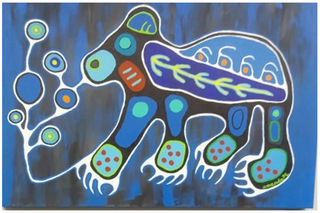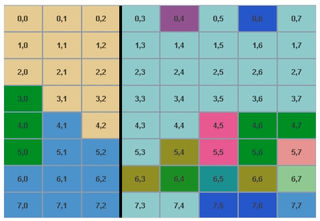Race and Ethnicity
Are Accusations of Cultural Appropriation Misguided?
The flirtatious dance of creative cultural expression and fusion transcends race
Posted April 29, 2017

I was saddened to learn this morning that the Toronto-based gallery 'Visions' canceled a show by non-Indigenous artist Amanda PL after concerns were raised that her art "bastardizes" Indigenous art.
Those who accuse Amanda of "cultural genocide" may have the good intension of preserving longstanding artistic traditions. Or they may be fuelled by monetary concerns; they may want to ensure that the flow of money for Indigenous style art is not "misdirected" toward non-Native artists. Or they may be motivated by guilt or anger over the horrendous historical mistreatment of native peoples and a desperate wish to somehow make up for it. Whatever their motive, I believe their actions are misguided, and in the long run serve to shut Indigenous art off from the natural ebb and flow and fusion of creative inspiration and expression that has unified different peoples since the dawn of humanity.
I research the creative process and how it fuels the evolution of culture. The creative impulse may draw inspiration from cultural traditions but it is not delimited by ethnicity. We are naturally able to draw upon anything at our disposal, anything we happen to stumble on that strikes a chord or resonates or affects us in some way, to work with as raw materials in creative process. When Isaac Newton said "If I have seen further, it is by standing on the shoulders of giants", the races of these "cultural giants" didn't matter; what mattered is that he had assimilated their ideas more deeply perhaps than their own biological children had. Their ideas then permeated Newton's thoughts, and under the influence of Newton's unique worldview (which was a function of his time, place, and so forth) gave birth to new ideas. The threads that connect Newton to the people whose ideas he built upon transcend human notions of race or creed or kin.
And cross-cultural creative influence isn't limited to cultural giants; it permeates our world, now more than ever. You may like to travel; perhaps you are creatively inspired by the food, or architecture, or artistic designs of someone with completely different cultural roots from your own. You'll never know the person who made that desert or designed that building or painted that painting. But what they created may sink itself so deep into your psyche that it affects you in conscious and unconscious ways, penetrates into your dreams, and ends up in your own creative expressions. Creative inspiration defies the labels and distinctions that humans use to categorize themselves.

I've written a computer model of cultural evolution called EVOC (for EVOlution of Culture) in which artificial "agents" interact with one another by sharing and creatively building on each others' ideas. It is highly simplified, so you have to take the results obtained with such a model with a grain of salt, but its outputs can sometimes surprise you in ways that bring to light forces operating in real societies, and get you to think about them more deeply. One of the things you can do with EVOC is erect artificial barriers that impede the flow of ideas between different 'cultural' groups. Sure, such a barrier effectively stops agents on one side from messing with ideas on the other side. But it slows down the evolution of ideas across the entire society as a whole, as well as reducing cultural diversity, and impeding the natural creative fusion of ideas that makes real human societies feel vital and "alive".
I'm concerned about the increasing frequency of claims of cultural appropriation, along with the labeling of artists who are authentically honouring the creative forms that inspire them, as "uneducated". I don't personally know Amanda PL, though I think her art is gorgeous and inspiring (you can check it out here). Nor do I personally know those who run the Visions gallery or who accused her of 'bastardizing' Indigenous art. But in my view, it is those who make such accusations who are engaging in cultural genocide. Such behaviour threatens to erect a fence around particular artistic forms that impedes their completely natural interaction with other artistic forms, and this kind of interaction is the hallmark of the creative process. Indeed, it isolates Indigenous art from the frothing sea of cultural interactions that defines our humanity and that enables culture to evolve.

Perhaps, had the exhibit not been shut down, someone would have bought a painting by Amanda instead of a painting by an Indigenous artist. But perhaps, had it not been shut down, young Indigenous artists, inspired by Amanda's perspective on their own cultural traditions, would have taken taken certain artistic forms in completely new and fascinating directions, opening up whole new realms of artistic possibility.
References
Gabora, L. (2008). EVOC: A computer model of the evolution of culture. In V. Sloutsky, B. Love & K. McRae (Eds.), 30th Annual Meeting of the Cognitive Science Society (pp. 1466-1471). North Salt Lake, UT: Sheridan Publishing. (Held July 23-26, Washington DC.) [http://arxiv.org/abs/1310.0522] https://people.ok.ubc.ca/lgabora/papers/conf_papers/evoc.pdf
Gabora, L. (2008). Modeling cultural dynamics. Proceedings of the Association for the Advancement of Artificial Intelligence (AAAI) Fall Symposium 1: Adaptive Agents in a Cultural Context (pp. 18-25). Menlo Park, CA: AAAI Press. (Held Nov 7-9, The Westin Arlington Gateway, Arlington VA.) [http://arxiv.org/abs/0811.2551] http://www.vub.ac.be/CLEA/liane/papers/AAAI08FS01Gabora.pdf


